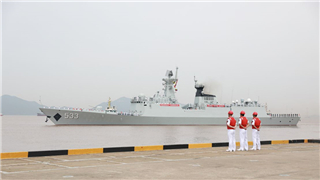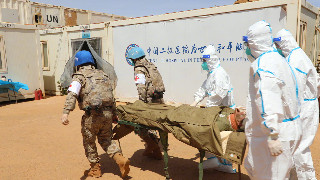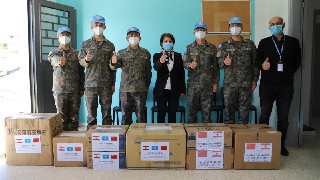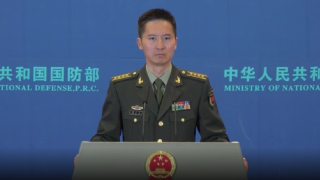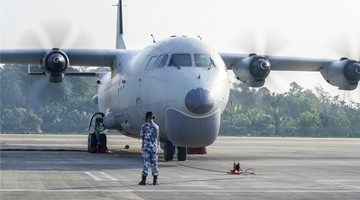By Hu Jiping
US President Joe Biden will start his Asia tour on May 20 and will hold talks with Japanese Prime Minister Fumio Kishida on May 23. According to Japanese media, Biden will not only reaffirm US "nuclear umbrella" for Japan, but also continue to strengthen the "extended deterrence" and write it into a joint document. This means that the US may deploy more weapons in Japan and further turn it into a military frontier in confrontation with major powers.
Japan's hype on the "China threat theory" has been escalating in recent years. After the outbreak of Russia-Ukraine conflict, Japan even took the opportunity to exaggerate that " changing the status quo with strength will also happen in East Asia." Former Japanese Prime Minister Shinzo Abe and others exaggerated the regional nuclear threat and proposed to consider "nuclear sharing", which became the direct background for the US to reaffirm the "nuclear umbrella".
The so-called "nuclear sharing" refers to the deployment of US nuclear weapons in Japan to be "shared" by the two countries. The US currently deploys tactical nuclear weapons in this way in five European countries including Germany. Some people in Japan want to achieve "nuclear possession" in the same way. US Defense Secretary Lloyd Austin reiterated "unwavering commitment to the defense of Japan and to include our extended deterrence commitments, using our full range of conventional and nuclear capabilities" during the US-Japan defense ministers' meeting on May 4. It may be regarded as a strategic appeasement for Japan.
However, the US's intention is clearly not just to comfort Japan. Taking China as its competitor, the US has been actively promoting the transformation and development of US military forces in the Asia-Pacific region. By stepping up efforts to win over regional allies, it aims to build a forward combat force with stronger strategic offensive capabilities and a higher level of combat readiness, including the deployment of hundreds of medium-range missiles in the region. Against such background, the US proposed "extended deterrence”, which means protecting its allies from attacks in all ways including the use of A-bomb, and strengthening military ties with allies, enhancing joint deterrence, and realizing its own strategic goals.
Japan is willing to "take the bait" to further strengthen its security cooperation with the US. In its Diplomatic Bluebook, Japan clearly stated that it is at the "front line" of the confrontation between the US and China. The Liberal Democratic Party of Japan announced in April its proposal to revise the national security strategy and other documents, positioning China as a "major security threat", and said it would explore ways to strengthen US security commitments, as well as how to use the US "extended deterrence" , which is mainly based on nuclear deterrence.
There are also shadows of American "hawks" behind the Japanese political circles and the rightwing forces in the process of promoting the major adjustment of Japan's security strategy. Japanese media reported that the Pentagon has long complained about Japan's "non-import" principle of nuclear weapons. Former Pentagon Official Elbridge Colby recently claimed that the measures proposed by Japan's Liberal Democratic Party to raise military spending to more than two percent of its GDP were "too late" and suggested that the US-South Korea model should be used to establish a US-Japan joint command. Fumio Kishida has always regarded nuclear disarmament as a "life-long career" and made it clear that he still adheres to the "three non-nuclear principles" and does not consider the option of "nuclear sharing". He also proposed to hold a G7 summit in Hiroshima next year and declare Japan's non-nuclear position.
From the perspective of strengthening the US "extended deterrence", whether it involves "nuclear sharing" or deploying new conventional weapons systems in Japan, US military bases in Japan have to be upgraded and even built. Japan currently holds 88 US military bases, most of which are in Okinawa. On the 50th anniversary of the so-called "return" of Okinawa, the issue concerning US military base has once again attracted attention. The local government and the public strongly demanded the Futenma base, which locates in the densely populated area, be moved out of Okinawa. However the appeal has been continuously rejected by the Japanese government. The locals also demanded the revise of the US-Japan Status of Forces Agreement, which grants the extraterritorial rights of the US military. And again, the Kishida government turned a deaf ear to that. This also reflects the Japanese government's intension to strengthen the presence of US troops in Japan.
After the World War II, Japan provided military bases to the US military in exchange for US military protection. But now, the strengthening of the US "extended deterrence" has gone beyond protecting Japan to conducting military confrontation with other countries. This is exactly in line with Japan's strategic ambitions.
What fits Japan's strategic interest is the ease of tensions between China and US and regional stability, rather than engaging in major power confrontations and making itself a military. The later would only increase the risk of involving itself in war. I wonder if the Japanese and Okinawan people are as prepared as Japanese "political elites" and right-wing politicians.
(The author is the vice president and researcher of the China Institute of Contemporary International Relations)
Editor's Note: This article is originally published on huanqiu.com, and is translated from Chinese into English and edited by the China Military Online. The information, ideas or opinions appearing in this article do not necessarily reflect the views of eng.chinamil.com.cn.
